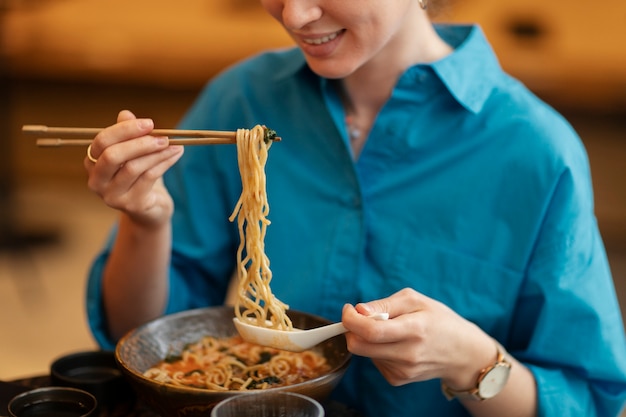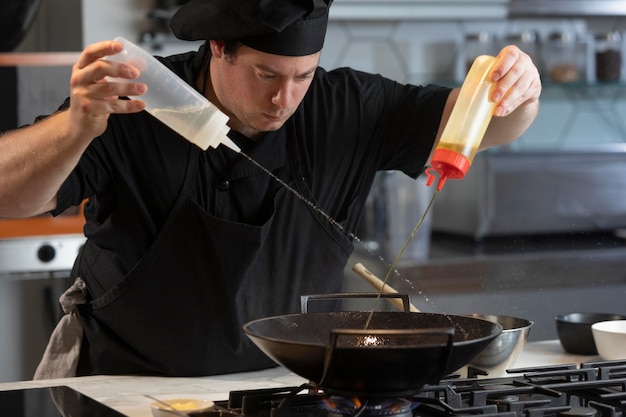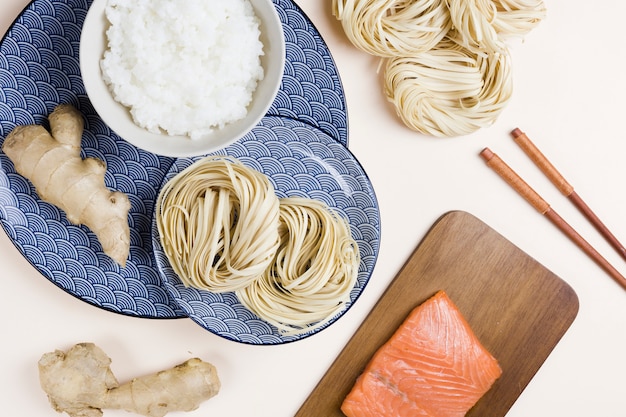Ah, noodles! Those delicious, versatile strands of culinary goodness. Whether you're a seasoned chef or a kitchen novice, we've all stared into a bubbling pot of water, wondering, "Are they done yet?". That anxiety about perfectly cooked noodles, not too soft, not too firm, is real! But fear not, noodle enthusiasts, I'm here to share my hard-earned wisdom and make you a noodle master.
Through years of experimentation (and the occasional soggy noodle disaster), I've discovered the secrets to achieving the perfect al dente bite. We're diving deep into the noodle world, exploring different types, understanding their cooking times, and unraveling those culinary mysteries. Get ready to whip up delicious noodle dishes with confidence – it's time to elevate your noodle game!
Part 1: The Noodle Cooking Fundamentals

Before we delve into the noodle variety, let's establish a strong foundation. These are the essential rules of the noodle game, the knowledge everyone needs before even considering boiling a pot of water.
1. The Abundant Water Principle
Imagine your noodles swimming freely, not crammed together in a crowded pot. That's the key to even cooking! Aim for a generous ratio of 8 cups of water to 1 cup of noodles. This ensures that each noodle gets its fair share of heat, preventing sticking and ensuring a lovely, light texture.
2. Salt: The Noodle's Best Friend
Don't be shy with the salt! A generous pinch adds flavor to the noodles themselves and helps them absorb the deliciousness of your sauce. Think of it as giving your noodles a little pep in their step before their culinary journey.
3. Avoid Overcrowding: A Spacious Pot is Key
Adding your noodles to a boiling pot is like inviting them to a party – everyone needs space! Overcrowding creates a noodle free-for-all, where they fight for heat and end up sticky and clumped together. Give them room to breathe and cook evenly.
4. The Al Dente Test: A Noodle Master's Secret
Ah, the holy grail of noodle cooking! "Al dente" is Italian for "to the tooth", signifying the perfect texture – tender yet with a slight bite. This is where you become a noodle detective, using your senses to assess perfection. Grab a noodle from the pot, take a bite, and pay attention. Is it pleasantly firm, with a slight resistance? Then you've reached al dente nirvana! Too soft? Cook it a bit longer. Still too firm? It needs more time in the hot water.
Part 2: The Noodle Family Tree: A Guide to Different Types of Noodles

Now that we've laid down the groundwork, let's explore the fascinating world of noodle variety. It's a diverse family, with each type boasting unique textures, flavors, and cooking times. Let's navigate this noodle jungle together!
1. The Wheat Noodle Clan: The Most Common Kind
Wheat noodles are the kings and queens of the noodle kingdom, crafted from wheat flour, water, and sometimes a touch of eggs. This family comes in an array of shapes and sizes, from the slender spaghetti strands to the thick, ribbon-like fettuccine.
1.1. The Long Noodle Lineage: Spaghetti and Beyond
Spaghetti, linguine, fettuccine, angel hair – these long, graceful noodles are known for their versatility. Typically, they need about 8-12 minutes in boiling water, depending on their thickness. Thinner noodles, like angel hair, cook faster than their thicker counterparts.
1.2. The Short Noodle Squad: Penne, Rigatoni, and Friends
Penne, rigatoni, farfalle (bowtie), and fusilli – these short, fun-shaped noodles have more surface area than their long cousins, making them excellent sauce catchers. Their cooking time usually hovers around 8-10 minutes, but keep an eye on them – they tend to overcook quickly.
1.3. Asian Wheat Noodles: A World of Flavor
The Asian wheat noodle scene is a world of its own, with a wide variety of textures and flavors. From the silky-smooth udon to the springy ramen, these noodles are a delight to explore. We'll dive deeper into their intricacies later.
2. The Rice Noodle Family: Light and Delicate
Made from rice flour and water, rice noodles possess a slightly chewy texture. They reign supreme in Southeast Asian cuisine, making an appearance in beloved dishes like pad thai and pho.
2.1. Vermicelli: Fine and Delicate
These thin, delicate noodles are a hallmark of Vietnamese cuisine. They cook quickly, usually in 2-3 minutes. Think of them as the nimble dancers of the noodle world.
2.2. Flat Rice Noodles: Broad and Versatile
Wider and flatter than vermicelli, these noodles are perfect for dishes like pad thai. They require a bit more cooking time, around 5-7 minutes, to achieve that perfect texture.
2.3. Rice Paper: Sheets of Culinary Magic
These thin, flat sheets are not technically cooked but softened in water before their starring role in spring rolls and wraps. They're the chameleons of the noodle world, taking on the flavors of their fillings.
3. The Egg Noodle Family: Rich and Chewy
Just as their name suggests, egg noodles include eggs in their ingredients, adding a richer flavor and a subtle yellow hue. They're often found in German and Eastern European cuisine, adding a delightful chewy texture to dishes.
4. Beyond the Basics: Other Noodle Types
The world of noodles extends far beyond wheat, rice, and eggs! Here are a few more intriguing options to explore:
- Glass Noodles: Made from mung bean starch, these translucent noodles have a delightfully chewy texture. They cook quickly, usually in 2-3 minutes.
- Buckwheat Noodles: Crafted from buckwheat flour, these noodles have a slightly nutty flavor, often found in Japanese cuisine. They typically cook for 5-7 minutes.
- Potato Noodles: These light and airy noodles are made from potato starch and cook quickly, usually in 2-3 minutes.
Part 3: Noodle Cooking Time Chart: Your Guide to Perfect Timing

You've got the basics down, you've met the noodle family, and now you're ready to conquer the kitchen. But don't worry, I've got your back! Here's a handy table outlining the approximate cooking times for various types of noodles. Remember, these are just estimates; always check the package directions for the most accurate information.
| Noodle Type | Cooking Time (minutes) |
|---|---|
| Spaghetti | 8-10 |
| Linguine | 8-10 |
| Fettuccine | 10-12 |
| Angel Hair | 5-7 |
| Penne | 8-10 |
| Rigatoni | 8-10 |
| Farfalle (Bowtie) | 8-10 |
| Fusilli | 8-10 |
| Udon | 4-5 |
| Ramen | 2-3 |
| Vermicelli | 2-3 |
| Flat Rice Noodles | 5-7 |
| Glass Noodles | 2-3 |
| Buckwheat Noodles | 5-7 |
| Potato Noodles | 2-3 |
Part 4: Mastering the Art of Noodle Cooking
You've got the basics down, the cooking times are at your fingertips, and you're ready to conquer the world of noodles. Now let's dive into the finer points, the little details that elevate your noodles from ordinary to extraordinary.
1. The Importance of a Rolling Boil: The Hot Water Secret
Ensure your water is at a rolling boil before adding the noodles. This guarantees even cooking and prevents a sticky mess. If the water is not hot enough, the noodles will take longer to cook and might not achieve that perfect al dente texture.
2. Stirring for Success: A Smooth Culinary Journey
Once your noodles hit the boiling water, give them a good stir! This prevents them from sticking together and helps them cook evenly. Think of it as a gentle nudge, guiding them towards their culinary destiny.
3. Don't Overcook! The Key to Al Dente Glory
The golden rule: cook your noodles just until they reach al dente. Overcooked noodles become mushy and lose their vibrant flavor. Start checking for al dente around the recommended cooking time, tasting a few noodles to ensure they're cooked to your liking.
4. Draining and Rinsing: The Finishing Touches
When your noodles are cooked, drain them in a colander. For stir-fries or dishes with sauce, you can drain them directly into the pan. If you're serving them with a simple sauce, rinsing with cold water will stop the cooking process, prevent them from sticking together, and ensure they stay firm.
Part 5: Noodle Storage and Leftover Magic
We've all been there: more noodles than you need! But don't fret, leftover noodles can be just as delicious as freshly cooked ones.
1. Storage Secrets: Keeping Noodles Fresh
Store leftover cooked noodles in an airtight container in the refrigerator. They'll keep well for up to 3 days, ready for a culinary comeback.
2. Leftover Noodle Hacks: Giving Noodles a Second Life
Don't let those leftover noodles go to waste! Here are some creative ways to give them a second life:
- Noodle Salad: Combine leftover noodles with your favorite vegetables, a protein, and a tangy dressing for a quick and satisfying salad.
- Stir-fried Noodles: Heat up leftover noodles with vegetables, meat, and a flavorful sauce for a delicious stir-fry.
- Noodle Soup: Add leftover noodles to a hearty soup for a comforting and satisfying meal.
Part 6: Noodle Wisdom from a Noodle Expert
You've mastered the basics, you've got the cooking times, and you're ready to conquer the world of noodles. But here's a little something extra – some insider tips from a noodle enthusiast who's cooked more than their fair share of pasta.
- Embrace Experimentation: Try different types of noodles, sauces, and cooking methods – you might discover your new favorite noodle dish!
- Taste as You Go: Don't blindly follow the cooking times. Taste your noodles as they cook to ensure they're cooked to your liking.
- Avoid Overcrowding: Give your noodles space to cook evenly and prevent sticking.
- Rinse Your Noodles: This helps to prevent them from sticking together and ensures they stay firm and delicious.
- Get Creative: Noodles are a blank canvas – use them as the base for your culinary creations and don't be afraid to experiment with flavors and textures.
Part 7: The Noodle World: A Culinary Journey
Let's take a culinary adventure around the world, exploring the diverse and delicious noodle dishes that have captured hearts and stomachs.
1. Italian Pasta: A Timeless Classic
From the classic spaghetti carbonara to the hearty lasagna, Italian pasta has been a culinary staple for centuries. The Italians have mastered the art of pasta-making, and their dishes are known for their simplicity and elegance.
2. Asian Noodle Dishes: A World of Flavor
The noodle scene in Asia is incredibly diverse, with each region boasting its own unique specialties. From the hearty ramen of Japan to the flavorful pho of Vietnam, Asian noodle dishes are a vibrant and delicious celebration of culinary creativity.
3. Noodle Dishes from Around the World: Global Culinary Delights
Noodles are not limited to Italy and Asia. Delicious noodle dishes are found all over the world, from the flavorful lo mein of China to the comforting pho of Vietnam.
Part 8: Noodle cooking faqs: Answers to Your Noodle Questions
You've absorbed a ton of noodle wisdom, but those lingering questions – the ones that keep popping up even after you think you've got it all figured out – are bound to arise. Don't worry, I've got you covered! Here are some of the most frequently asked questions about noodle cooking.
1. Can I Cook Noodles in the Microwave?
While you can cook noodles in the microwave, it's not the ideal method. microwave cooking can lead to unevenly cooked noodles and a less-than-desirable texture. For the best results, stick to traditional stovetop cooking.
2. How Do I Know When Noodles are Done?
The best way to determine if noodles are done is to taste them! Check for al dente, which means they have a slight resistance when you bite into them. They should be tender but still have a bit of a bite. If they're too soft, they need more cooking time. If they're still too firm, they need to cook a bit longer.
3. What Happens if I Overcook Noodles?
Overcooked noodles become mushy and lose their flavor. If you're worried about overcooking your noodles, start checking for al dente around the recommended cooking time. Taste a few noodles to ensure they're cooked to your liking. If they're still too firm, you can always cook them a bit longer.
4. Can I Reuse the Noodle Water?
Absolutely! The starchy water, known as "pasta water," can be used to create flavorful sauces. It adds body and depth to your sauce, enhancing its overall texture and taste.
5. What are Some Good Noodle Recipes?
There are endless possibilities when it comes to noodle recipes! You can find inspiration online, in cookbooks, or even in your own kitchen. Here are a few ideas to get you started:
- Spaghetti Carbonara: A classic Italian dish with a creamy sauce made with eggs, cheese, and pancetta.
- Pad Thai: A flavorful Thai dish with stir-fried rice noodles, shrimp, tofu, and peanuts.
- Pho: A Vietnamese noodle soup with fragrant broth, rice noodles, meat, and herbs.
- Ramen: A Japanese noodle soup with rich broth, noodles, meat, and vegetables.
Congratulations! You're now armed with the knowledge to cook noodles like a pro. Remember, the key to great noodles is to cook them just until they're al dente. Don't be afraid to experiment, and most importantly, enjoy the process. Happy noodle-making!
Everyone is watching

Prime Rib Roast Cooking Time Chart: Per Pound Guide
Cooking TipsPrime rib roast. Just the name conjures images of lavish dinners, crackling fires, and hearty laughter. It’s ...

How Long to Bake Potatoes in the Oven (Perfect Every Time)
Cooking TipsBaked potatoes are a staple in my kitchen. They're incredibly versatile, delicious, and surprisingly easy to m...

Perfect Rice Every Time: The Ultimate Guide to Cooking Rice
Cooking TipsAs a self-proclaimed foodie, I've always been a bit obsessed with rice. It's the foundation of countless cuisi...

The Ultimate Guide to Cooking Asparagus: Tips, Techniques, and Recipes
Cooking TipsAsparagus. The mere mention of this spring delicacy conjures up images of vibrant green spears, crisp and burs...

Ultimate Guide to Cooking the Perfect Thanksgiving Turkey
Cooking TipsThanksgiving. Just the word conjures up images of overflowing tables laden with delicious food, the scent of r...
